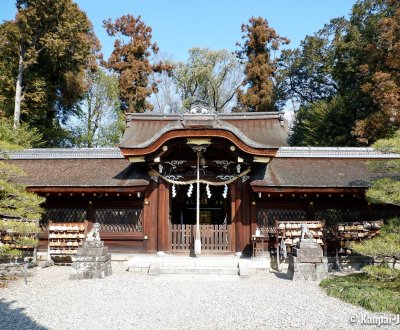Umenomiya Taisha
Western Kyoto’s Plum Blossoms and Sake Shrine
Umenomiya Taisha is an ancient Shinto shrine located in Ukyo, a residential ward in the west of Kyoto. An important spiritual site during the Nara and Heian periods, the shrine is now popular among sake brewers and expecting women. Visitors can also enjoy a little Japanese garden brightened by plum blossoms in winter and blooming irises in summer.
Founded during the Nara period (710 – 794), Umenomiya shrine was initially named "Umemiya-jinja" and located in the Yamashiro province (southern part of Kyoto prefecture). It was serving the Tachibana clan, a noble and influential family at the Imperial Court of Heijo (future Nara), then Heian (future Kyoto). It was moved to its current location in the west of Kyoto thanks to Tachibana no Kachiko (786 – 850), also known as Empress Danrin-kogo and 1rst spouse of Emperor Saga (786 - 842).

Kami of sake and easy childbirth since Classical times
Tachibana no Kachiko, convinced of her infertility, eventually gave birth to future emperor Ninmyo (808 – 850), a miracle she attributed to the providential intervention of kami Oyamazumi no Mikoto (or Oyamatsumi). The tutelary deity of the Tachibana clan and main god of the shrine, he was initially worshiped as a god of the mountains and the seas. Therefore, Umenomiya Taisha became a Shinto site where people have been praying to this day to have children and an easy childbirth. The place is also enshrining Oyamazumi’s daughter: princess Konohana-no-Sakuya, the goddess of Mount Fuji 🗻 also associated to fertility and procreation.
Later, thanks to his roles as the god of the mountains from which pure water is springing, and the grandfather of Konohana-no-Sakuya’s 3 beautiful children, Oyamazumi no Mikoto was elevated to the title of kami of sake 🍶, the brewer of traditional Japanese alcohol to celebrate a happy birth. He is therefore worshiped by nihonshu brewers and a yearly celebration, called Amazake Matsuri, is held on each February 11 in Umenomiya Taisha for this local industry’s prosperity. Note that neighboring shrine Matsunoo Taisha is also a place frequented by Kyoto’s sake makers.
Strongly connected to the Japanese aristocracy since the Classical times, Umenomiya shrine has long benefited from the Imperial Court patronage and was classified as:
- Myojin Taisha, a great shrine home to deities performing remarkable miracles;
- Nijuni-sha in 994 by emperor Ichijo, one of the 22 Shrines of the Heian period (794 - 1185) that was granted specific offerings; and,
- Kanpei-chusha until 1946, a government supported second-rank Shinto shrine.

Japanese garden with plum trees and blooming irises
Now located off the center in a residential neighborhood and far from the tourist crowds visiting Kyoto, Umenomiya Taisha has lost of its luster and influence on the local life. Except for the few usual yearly Shinto celebrations, the shrine is not very busy and lately has been attracting a quietness-loving hairy population. A group of about 10 cats has indeed taken up its quarters in the shrine’s grounds, and cat 🐈 lovers will be happy to see them roaming in the alleys or napping in the sun.
The visit of the spiritual site ends on a high note at Shinen, the traditional Japanese garden with a short walk around a pond and a view on an ancient tea house. Seasonality is important and the landscape is particularly interesting at 2 moments of the year:
- At the end of winter (February to early March), when its 450 ume plum trees blossom; and,
- At the end of spring / start of summer (in June) thanks to the blooming hydrangeas and irises around the small Magatama pond.
Umenomiya Shrine is not a must-see, and is best enjoyed from spring 🌸 to autumn 🍁, when the vegetation is at its peak, for tourists already visiting the area along the Katsura River towards Arashiyama.



